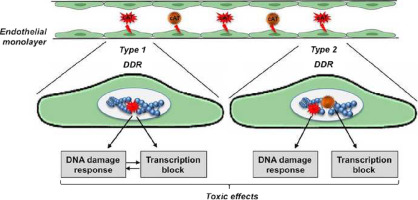当前位置:
X-MOL 学术
›
BBA Mol. Cell Res.
›
论文详情
Our official English website, www.x-mol.net, welcomes your
feedback! (Note: you will need to create a separate account there.)
Anticancer drug and ionizing radiation-induced DNA damage differently influences transcription activity and DDR-related stress responses of an endothelial monolayer.
Biochimica et Biophysica Acta (BBA) - Molecular Cell Research ( IF 4.6 ) Pub Date : 2020-02-14 , DOI: 10.1016/j.bbamcr.2020.118678 Verena Ziegler 1 , Marco Deußen 1 , Lena Schumacher 1 , Wynand P Roos 2 , Gerhard Fritz 1
Biochimica et Biophysica Acta (BBA) - Molecular Cell Research ( IF 4.6 ) Pub Date : 2020-02-14 , DOI: 10.1016/j.bbamcr.2020.118678 Verena Ziegler 1 , Marco Deußen 1 , Lena Schumacher 1 , Wynand P Roos 2 , Gerhard Fritz 1
Affiliation

|
The endothelium contributes to the pathophysiology of adverse effects caused by conventional (genotoxic) anticancer therapeutics (cAT). The relevance of structurally different types of cAT-induced DNA lesions for eliciting selected endothelial stress responses is largely unknown. Here, we analyzed the cAT-induced formation of DNA double-strand breaks (DSB), transcription blockage and DNA damage response (DDR) in time kinetic analyses employing a monolayer of primary human endothelial cells (HUVEC). We observed that the degree of cAT-induced transcription blockage, the number of DSB and activation of DDR-related factors diverge. For instance, ionizing radiation caused the formation of numerous DSB and triggerd a substantial activation of ATM/Chk2 signaling, which however were not accompanied by a significant transcription inhibition. By contrast, the DNA cross-linking cAT cisplatin triggered a rapid and substantial blockage of transcription, which yet was not reflected by an appreciable number of DSB or increased levels of pATM/pChk2. In general, cAT-stimulated ATM-dependent phosphorylation of Kap1 (Ser824) and p53 (Ser15) reflected best cAT-induced transcription blockage. In conclusion, cAT-induced formation of DSB and profound activation of prototypical DDR factors is independent of the inhibition of RNA polymerase II-regulated transcription in an endothelial monolayer. We suggest that DSB formed directly or indirectly following cAT-treatment do not act as comprehensive triggers of superior signaling pathways shutting-down transcription while, at the same time, causing an appreciable stimulation of the DDR. Rather, it appears that distinct cAT-induced DNA lesions elicit diverging signaling pathways, which separately control transcription vs. DDR activity in the endothelium.
中文翻译:

抗癌药和电离辐射诱导的DNA损伤以不同方式影响内皮细胞单层的转录活性和DDR相关的应激反应。
内皮有助于由常规(遗传毒性)抗癌治疗剂(cAT)引起的不良反应的病理生理学。在很大程度上,结构不同类型的cAT诱导的DNA损伤与引起选定的内皮应激反应的相关性尚不清楚。在这里,我们采用单层原代人内皮细胞(HUVEC)在时间动力学分析中分析了cAT诱导的DNA双链断裂(DSB),转录阻滞和DNA损伤反应(DDR)的形成。我们观察到cAT诱导的转录阻滞程度,DSB的数量和DDR相关因子的激活存在差异。例如,电离辐射导致大量DSB的形成,并触发了ATM / Chk2信号转导的实质性激活,但是并没有明显的转录抑制作用。相比之下,DNA交联的cAT顺铂触发了快速而实质的转录阻断,但尚未被可观的DSB数量或pATM / pChk2水平升高所反映。通常,cAT刺激的Kap1(Ser824)和p53(Ser15)的ATM依赖性磷酸化反映了cAT诱导的最佳转录阻滞。总之,cAT诱导的DSB的形成和原型DDR因子的深度激活独立于RNA聚合酶II调节的内皮单层转录的抑制。我们建议,直接或间接在cAT处理后形成的DSB不能作为关闭转录的高级信号通路的全面触发,而同时会引起DDR的明显刺激。而是
更新日期:2020-02-20
中文翻译:

抗癌药和电离辐射诱导的DNA损伤以不同方式影响内皮细胞单层的转录活性和DDR相关的应激反应。
内皮有助于由常规(遗传毒性)抗癌治疗剂(cAT)引起的不良反应的病理生理学。在很大程度上,结构不同类型的cAT诱导的DNA损伤与引起选定的内皮应激反应的相关性尚不清楚。在这里,我们采用单层原代人内皮细胞(HUVEC)在时间动力学分析中分析了cAT诱导的DNA双链断裂(DSB),转录阻滞和DNA损伤反应(DDR)的形成。我们观察到cAT诱导的转录阻滞程度,DSB的数量和DDR相关因子的激活存在差异。例如,电离辐射导致大量DSB的形成,并触发了ATM / Chk2信号转导的实质性激活,但是并没有明显的转录抑制作用。相比之下,DNA交联的cAT顺铂触发了快速而实质的转录阻断,但尚未被可观的DSB数量或pATM / pChk2水平升高所反映。通常,cAT刺激的Kap1(Ser824)和p53(Ser15)的ATM依赖性磷酸化反映了cAT诱导的最佳转录阻滞。总之,cAT诱导的DSB的形成和原型DDR因子的深度激活独立于RNA聚合酶II调节的内皮单层转录的抑制。我们建议,直接或间接在cAT处理后形成的DSB不能作为关闭转录的高级信号通路的全面触发,而同时会引起DDR的明显刺激。而是











































 京公网安备 11010802027423号
京公网安备 11010802027423号